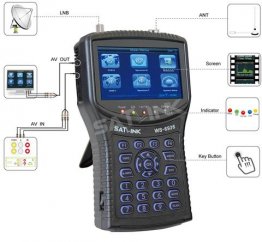Satellite dish signal strength meter

Television satellites are in stationary geosynchronous orbits, so if the azimuth and elevation are known, a dish antenna can be aimed with fair accuracy using a simple compass. The azimuth is the angle relative to true north while the elevation is the angle above the horizon. A Satellite Signal Finder meter offera better accuracy, especially on the edge of a satellite’s footprint. Digital meters are indispensable tools for satellite TV installers. They’re equally handy for the home or a recreational vehicle. We have pulled together a list of the top choices for satellite signal strength meters and review them below.
Satellite Signal Finder – Review
The Triplett 3275 Satellite Signal Finder is representative of basic signal strength meters. This unit features a sensitive MMIC, a high-gain amplifier with low noise characteristics at microwave frequencies and an internal attenuator to reduce the gain with strong signals. See Product Features…
It uses an analog meter to display signal strength, typical of most low-cost meters. It also incorporates an audible tone that changes pitch with signal strength, allowing one person to do the job of aligning a satellite antenna. This economical satellite signal finder is a good choice for the do-it-yourself hobbyist or RV owner.
The Acutrac22 PRO Satellite Meter is a step up from low cost meters, with a digital display in place of an analog meter. It’s capable of tracking two satellites at once. The dual display is useful when trying to align an antenna for the best possible signal by “splitting the difference” between satellites. Like the Triplett 3275, the Accutrac 22Pro Mk II includes an audible tone that changes pitch with signal strength. See Product Features…
Digital meters for professional use perform all the same basic functions as their less expensive counterparts. They provide faster set-up time, however, and this is a critical issue for service calls and every day operation.
The Birdog USB Plus Satellite Meter is built like a bench meter. It’s capable of receiving two satellites simultaneously, and like the Accutrac 22 Pro MkII, it has a digital display. It also tests coaxial cable and low-noise block converters (LNBs).
This satellite signal finder includes a spectrum analyzer, a graphic representation of signal strength and frequency that is helpful with finding carrier frequencies. The Birdog Ultra includes memory functions and a USB port for transferring information to a personal computer. It carries a look-up table based on zip codes that helps establish the initial antenna settings for any available satellite. See Product Features…
Another quality satellite signal finder is the First Strike FS1 comes in a rugged yellow case like many field service meters. It has a global data base containing all current satellites and also includes a separate data base for up to 100 user entries. Unlike the Birdog Ultra, the First Strike FS1 does not have an internal look-up table for locations. Instead, the user must enter the latitude and longitude. Once the position is known, the meter provides a list of available channels. See Product Features…
How To Use A Satellite Signal Finder
Turn off the power to the satellite receiver. Connect the digital meter in-line between the receiver and the LNB. Some meters have an LED that lights up when the coaxial cable is connected properly. Consult a satellite position table and turn the antenna to provide an approximate alignment. If required, set the meter movement to the initial position using the gain control.Slowly rotate the dish for the highest indicated signal or highest pitch tone. If the needle or display exceeds full scale, reduce the gain slightly.
Related posts:

 How to make squash How to remote control desktop using lan tricks Tricks for keeping marks off your nose when wearing sunglasses Quickbooks help how to enter tips…
How to make squash How to remote control desktop using lan tricks Tricks for keeping marks off your nose when wearing sunglasses Quickbooks help how to enter tips… As both J.D. Power and Associates and Consumer Reports have noted, satellite enjoys a superior customer service rating among its multichannel competitors. Sustaining…
As both J.D. Power and Associates and Consumer Reports have noted, satellite enjoys a superior customer service rating among its multichannel competitors. Sustaining… What does tin stand for Tips on how to breed better dragons in dragonvale Linus tech tips how to build a pc what does negative mean what is capital murders mean…
What does tin stand for Tips on how to breed better dragons in dragonvale Linus tech tips how to build a pc what does negative mean what is capital murders mean… Simply activate the receiver through an existing DISH account or subscribe to a new Pay-As-You-Go programming package. Pathway X2 can point to either Western or…
Simply activate the receiver through an existing DISH account or subscribe to a new Pay-As-You-Go programming package. Pathway X2 can point to either Western or… A Dish Network digital video recorder (DVR) is controlled by a specialized remote that is provided with it. The Dish Network remote uses a code that allows it to…
A Dish Network digital video recorder (DVR) is controlled by a specialized remote that is provided with it. The Dish Network remote uses a code that allows it to…